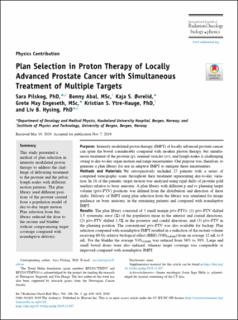| dc.contributor.author | Abal, Bonny | |
| dc.contributor.author | Øvrelid, Kaja Slåtsve | |
| dc.contributor.author | Engeseth, Grete May | |
| dc.contributor.author | Ytre-Hauge, Kristian | |
| dc.contributor.author | Hysing, Liv Bolstad | |
| dc.contributor.author | Pilskog, Sara | |
| dc.date.accessioned | 2021-05-14T06:46:08Z | |
| dc.date.available | 2021-05-14T06:46:08Z | |
| dc.date.created | 2020-07-30T13:29:22Z | |
| dc.date.issued | 2020 | |
| dc.Published | International Journal of Radiation Oncology, Biology, Physics. 2020, 106 (3), 630-638. | |
| dc.identifier.issn | 0360-3016 | |
| dc.identifier.uri | https://hdl.handle.net/11250/2755243 | |
| dc.description.abstract | Purpose
Intensity modulated proton therapy (IMPT) of locally advanced prostate cancer can spare the bowel considerably compared with modern photon therapy, but simultaneous treatment of the prostate (p), seminal vesicles (sv), and lymph nodes is challenging owing to day-to-day organ motion and range uncertainties. Our purpose was, therefore, to generate a plan library for use in adaptive IMPT to mitigate these uncertainties.
Methods and Materials
We retrospectively included 27 patients with a series of computed tomography scans throughout their treatment representing day-to-day variation. In 18 of the patients, target motion was analyzed using rigid shifts of prostate gold markers relative to bony anatomy. A plan library with different p and sv planning target volume (p/sv-PTV) positions was defined from the distribution and direction of these shifts. Delivery of IMPT using plan selection from the library was simulated for image guidance on bony anatomy, in the remaining patients and compared with nonadaptive IMPT.
Results
The plan library consisted of 3 small margin p/sv-PTVs: (1) p/sv-PTV shifted 1.5 systematic error (Σ) of the population mean in the anterior and cranial directions, (2) p/sv-PTV shifted 1.5Σ in the posterior and caudal directions, and (3) p/sv-PTV in the planning position. The conventional p/sv-PTV was also available for backup. Plan selection compared with nonadaptive IMPT resulted in a reduction of the rectum volume receiving 60 Gy relative biological effect (RBE) (V60GyRBE) from on average 12 mL to 9 mL. For the bladder the average V45GyRBE was reduced from 36% to 30%. Large and small bowel doses were also reduced, whereas target coverage was comparable or improved compared with nonadaptive IMPT.
Conclusions
Plan selection based on a population model of rigid target motion was feasible for all patients. Compared with conventional IMPT, plan selection resulted in significant dosimetric sparing of rectum and bladder without compromising target coverage. | en_US |
| dc.language.iso | eng | en_US |
| dc.publisher | Elsevier | en_US |
| dc.rights | Attribution-NonCommercial-NoDerivatives 4.0 Internasjonal | * |
| dc.rights.uri | http://creativecommons.org/licenses/by-nc-nd/4.0/deed.no | * |
| dc.title | Plan Selection in Proton Therapy of Locally Advanced Prostate Cancer with Simultaneous Treatment of Multiple Targets | en_US |
| dc.type | Journal article | en_US |
| dc.type | Peer reviewed | en_US |
| dc.description.version | publishedVersion | en_US |
| dc.rights.holder | Copyright 2019 The Author(s). | en_US |
| cristin.ispublished | true | |
| cristin.fulltext | original | |
| cristin.qualitycode | 1 | |
| dc.identifier.doi | 10.1016/j.ijrobp.2019.11.007 | |
| dc.identifier.cristin | 1821057 | |
| dc.source.journal | International Journal of Radiation Oncology, Biology, Physics | en_US |
| dc.source.40 | 106 | |
| dc.source.14 | 3 | |
| dc.source.pagenumber | 630-638 | en_US |
| dc.identifier.citation | International Journal of Radiation Oncology, Biology, Physics. 2020, 106 (3), 630-638. | en_US |
| dc.source.volume | 106 | en_US |
| dc.source.issue | 3 | en_US |

